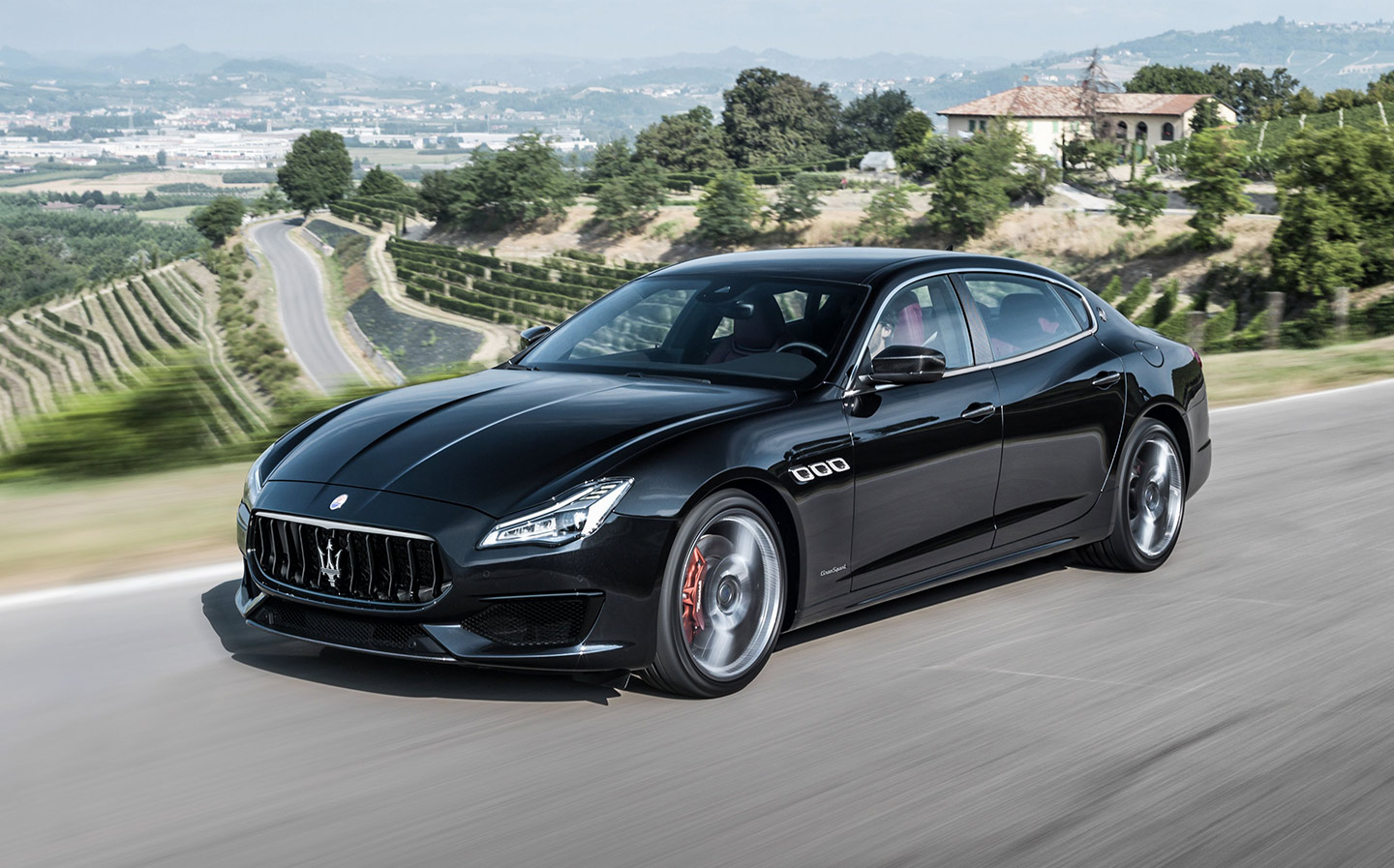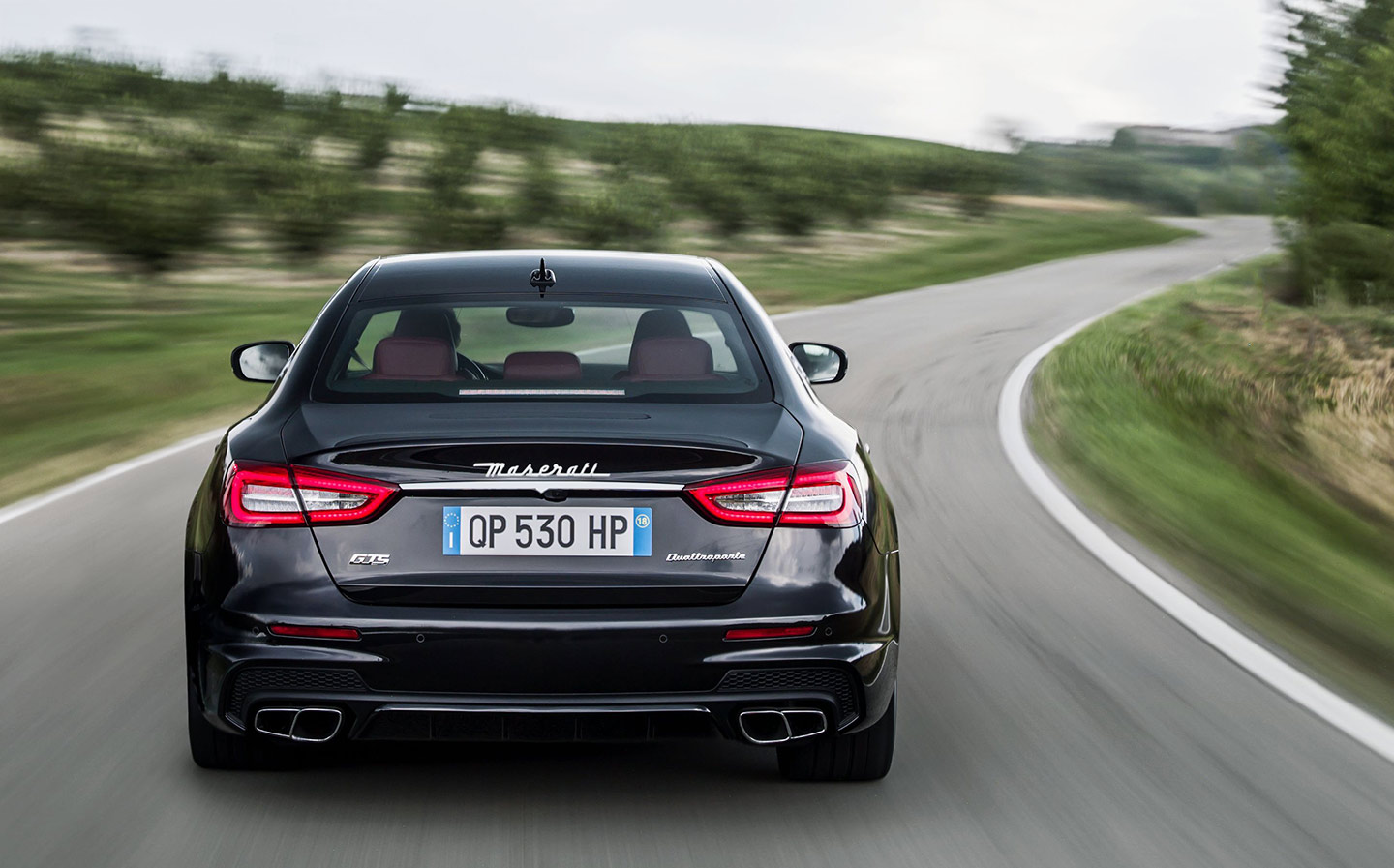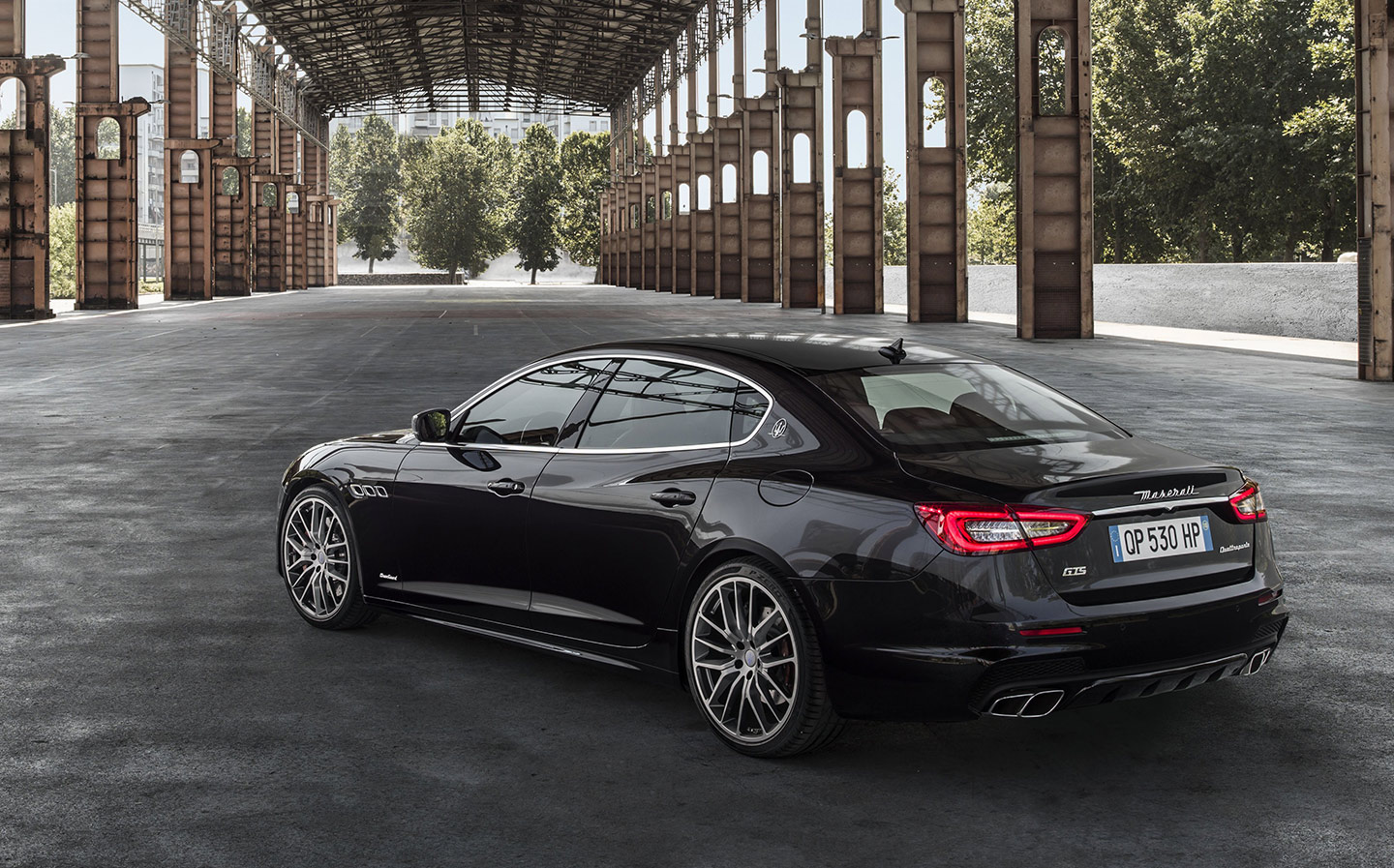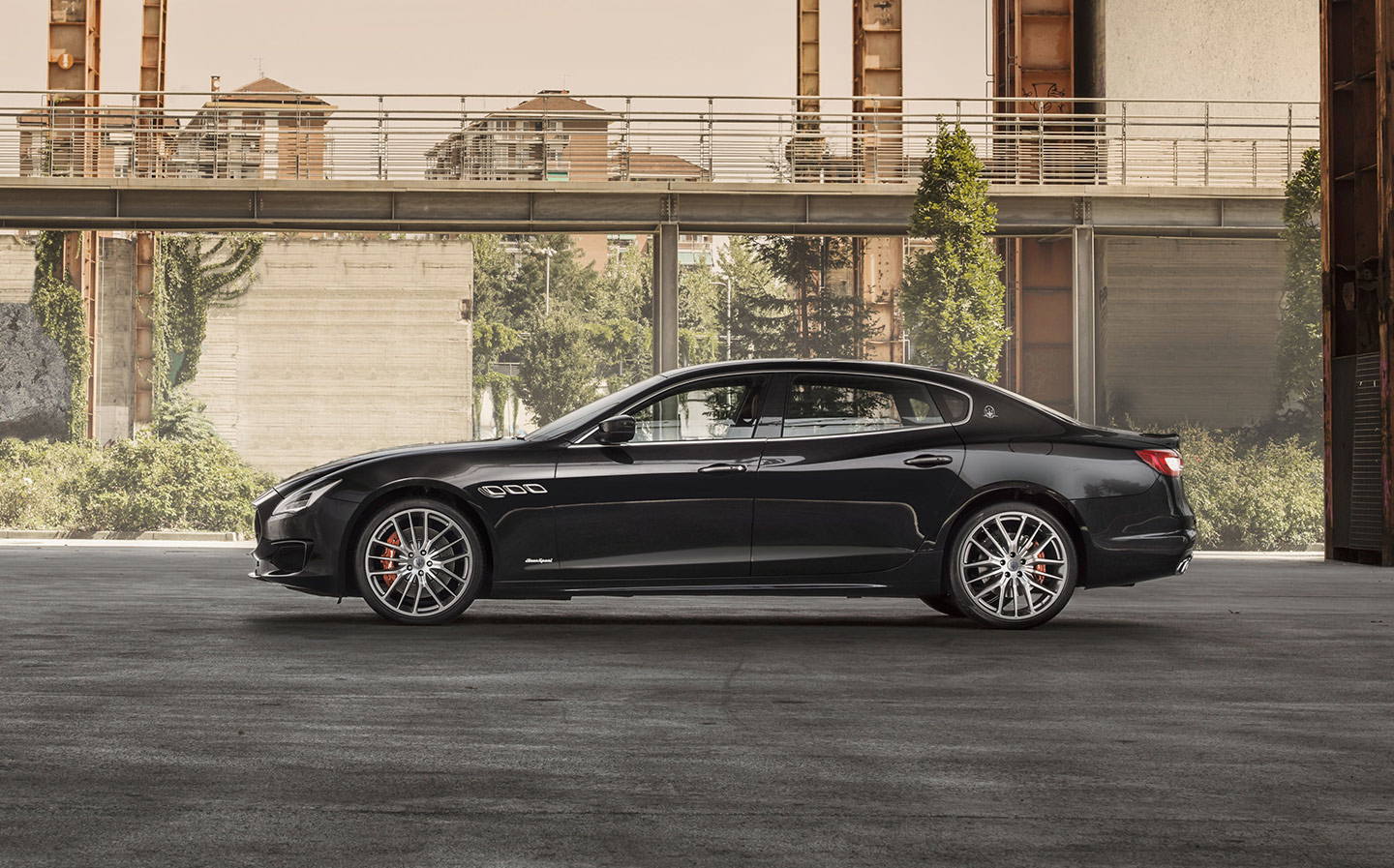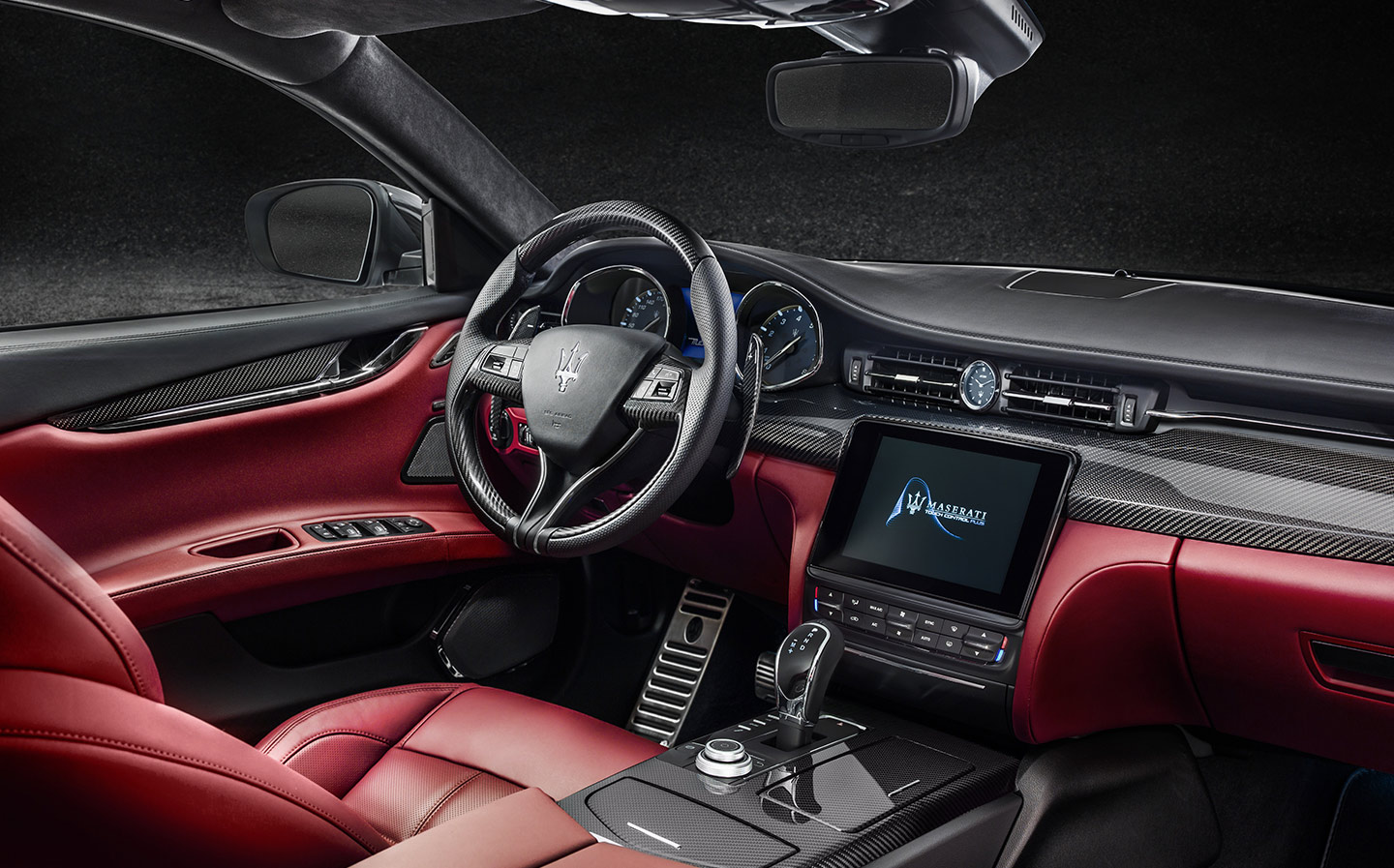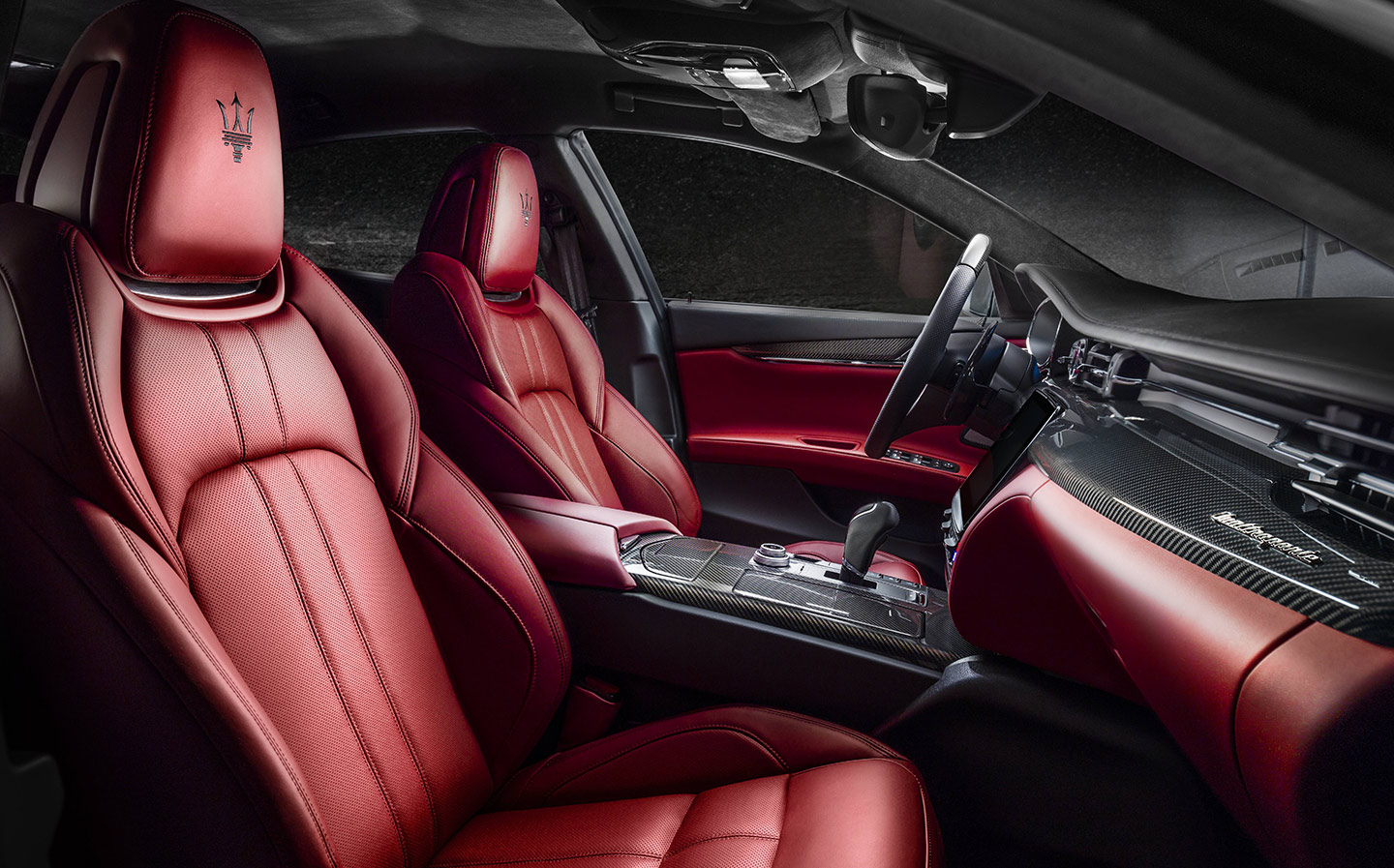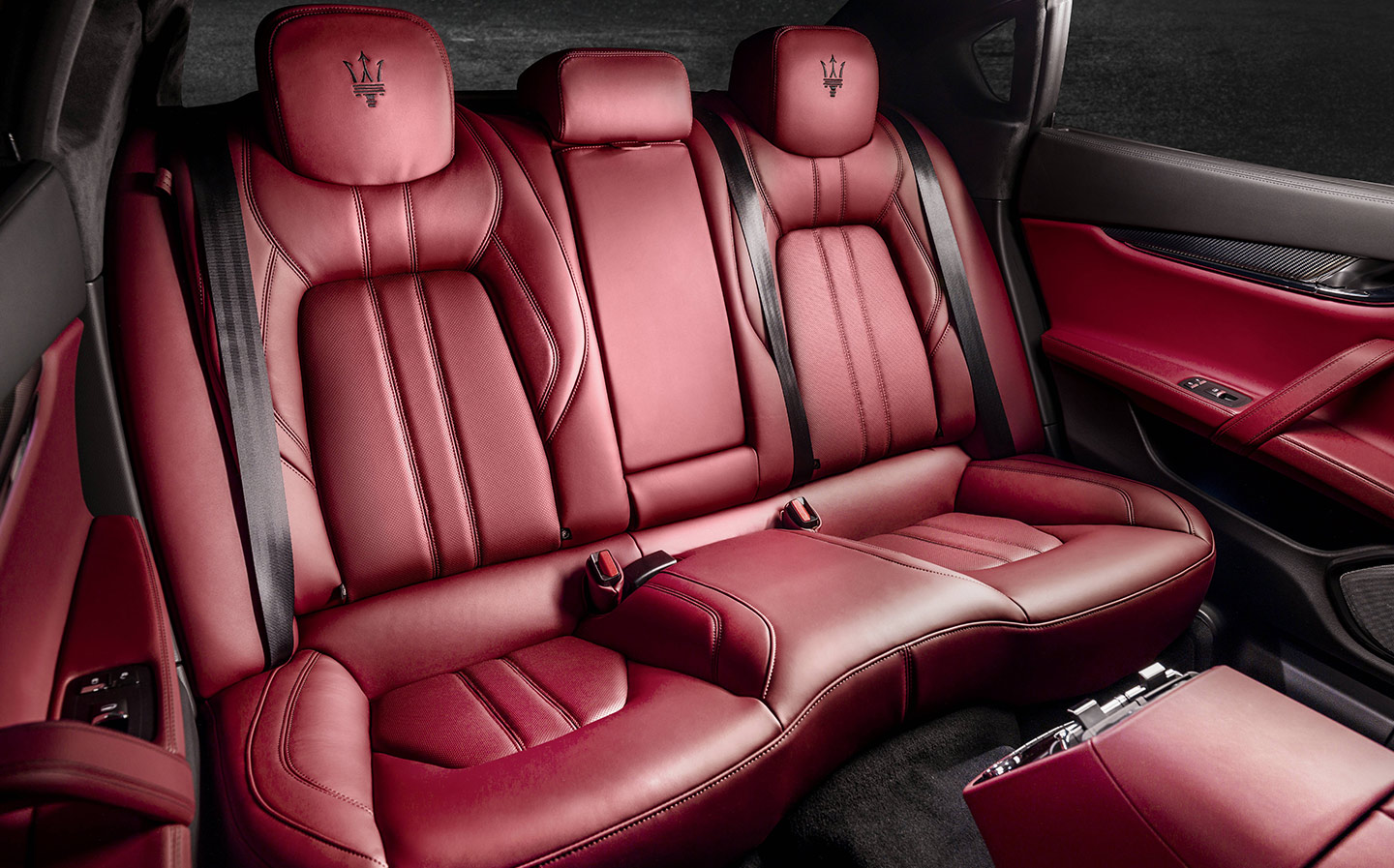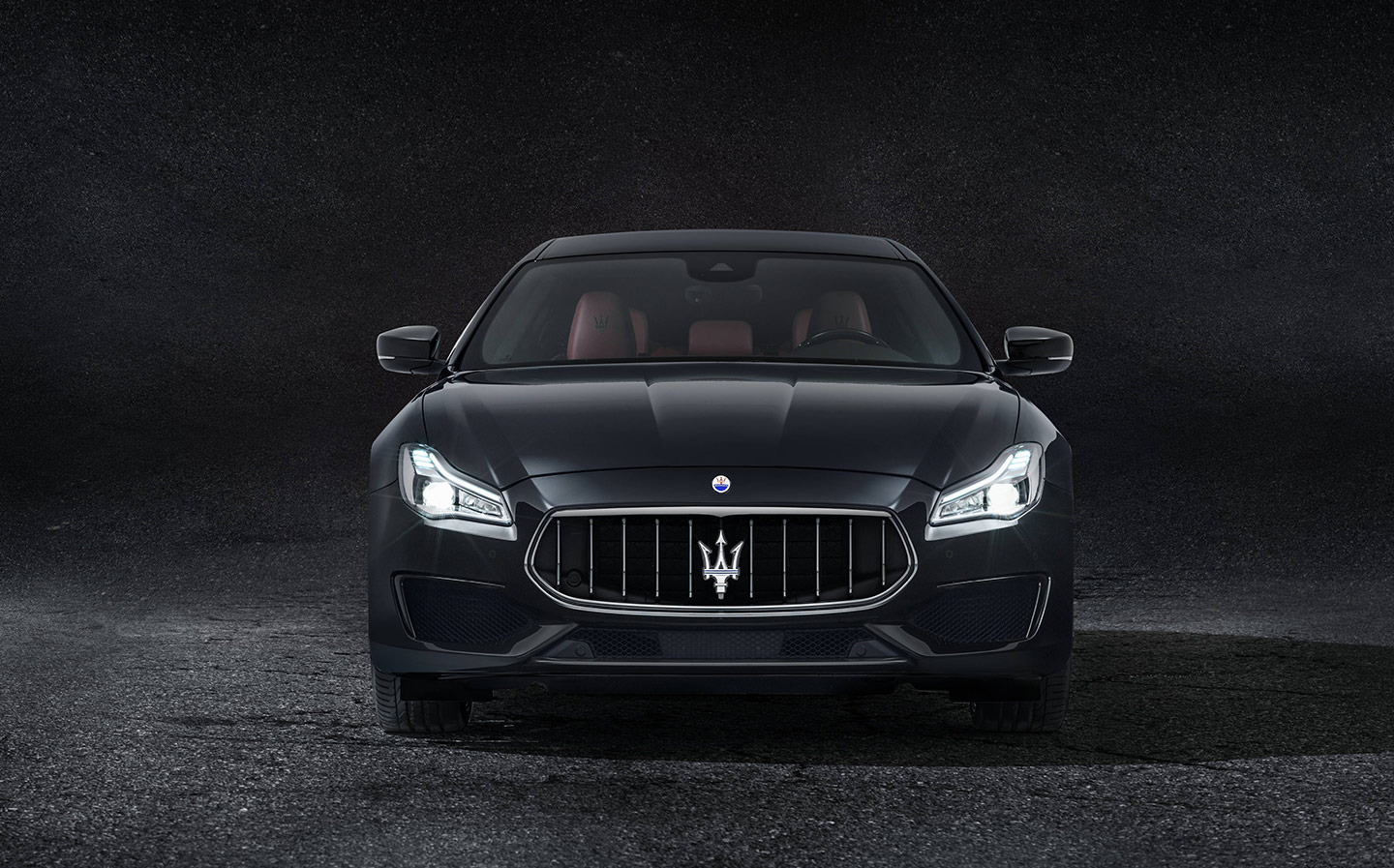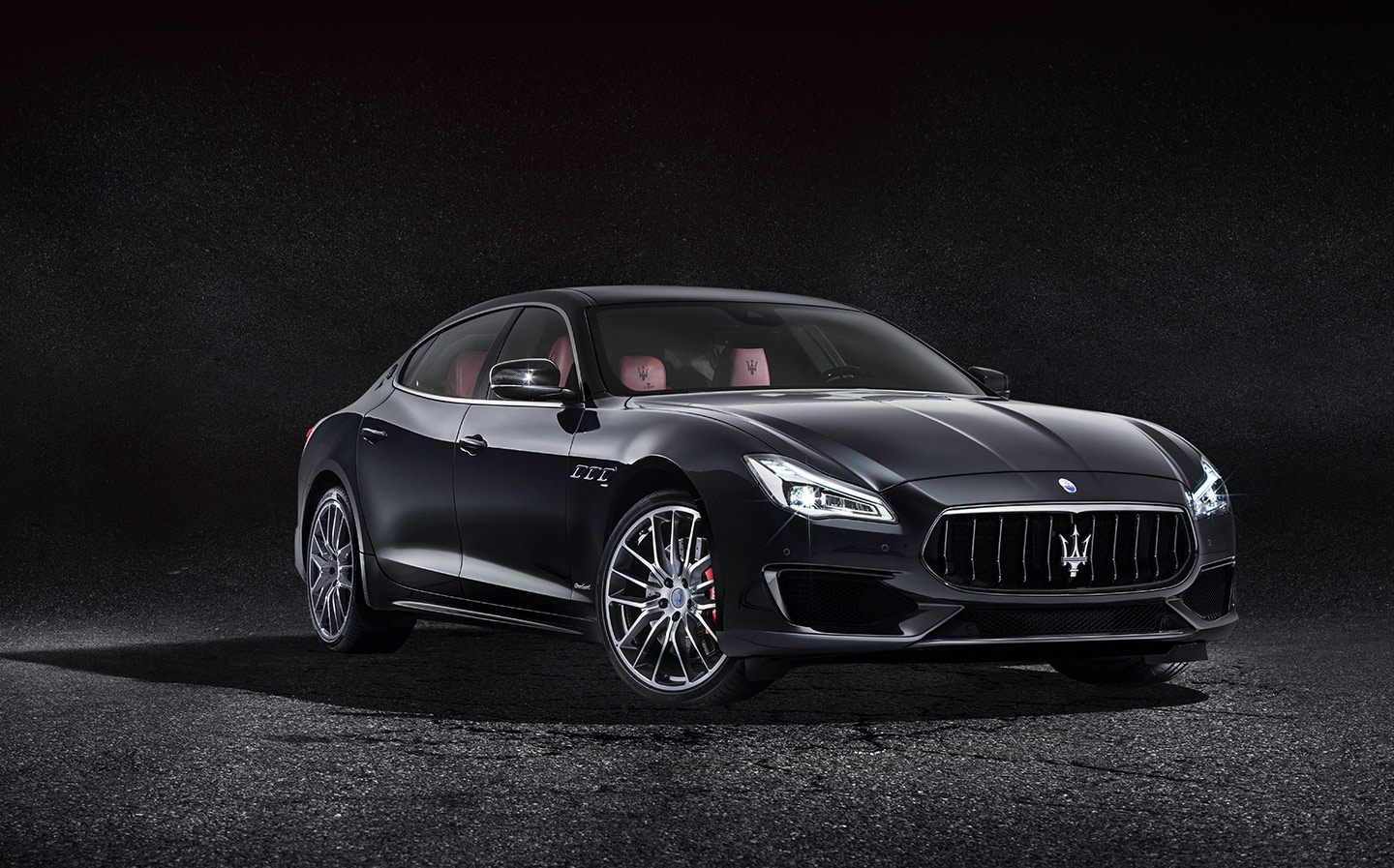First Drive review: 2018 Maserati Quattroporte
One step behind the competition, but that's just how we like it
-
Handling
-
Comfort
-
Performance
-
Design
-
Interior
-
Practicality
-
Costs
- Variant: Quattroporte 3.8 V8 GranLusso GTS
- Price: £118,525
- Engine: 3,799cc, twin-turbocharged V8, petrol
- Power: 523bhp @ 6,500rpm
- Torque: 479 lb ft @ 2,250rpm
- Transmission: 8-speed auto with manual mode, rear-wheel drive
- Acceleration: 0-62mph: 4.7sec
- Top Speed: 193mph
- Fuel: 26.4mpg
- co2: 250g/km
- Road tax band: £1,700 for first year; £450 for years 2-6; £140 thereafter
- Dimensions: 5,262mm x 1,948mm x 1,481mm
- Release Date: On sale now
IN MOTORING journalism, certain cliches must be avoided at all costs. Don’t say that a car holds the road “as if it’s on rails”, for example, or describe its acceleration as “taking off like a scalded cat”. Another good one is mentioning that Quattroporte sounds beautiful in Italian but isn’t so impressive when translated into the English, “Four doors”. It is an amusing observation the first time, mind you.
It’s hard to avoid such cliches when writing about the Maserati Quattroporte, though. Updated for 2018, the luxury sports saloon car has been known for its elegant styling, wonderful engine note, power and – some would say – soul, not to mention the natural association with the brand’s heritage in motor racing. Pretty much every Quattroporte since the first model was launched in 1963 has been synonymous with such things.
They have also been known for some less impressive qualities: slightly disappointing handling, on occasion, questionable reliability, the tendency to lose value faster than a state-run construction firm, and the general feeling that, in most areas, the Quattroporte is not quite as good as its German rivals.
Browse NEW or USED cars for sale
As such, buying the Maserati over a Porsche Panamera or BMW 6-series Gran Coupe, or even an Aston Martin Rapide, has been a decision of the heart rather than one of the head.
It should be noted, though, that the current, sixth-generation Quattroporte, launched in 2013, is the most successful version to date, in terms of sales, with a burgeoning customer base in the Middle East and China, where quality, status and comfort are more important considerations than handling, efficiency or residual value.
The good news is that the Mk6 Quattroporte has been generally well received in the UK, too. Curiously, one of the things that has worked in its favour over here has come about as a result of a criticism; Maserati seems to be one step behind the competition technically, which meant that while rivals introduced fancy-pants electronic driver aids and electric steering, the Quattroporte stuck with relatively unsophisticated safety systems and hydraulic steering, even when it received a mid-life refresh for 2017.
Those who consider themselves true wheelsmiths will tell you that hydraulic steering offers a superior drive as it affords better feedback from the road, so they’ll no doubt be irked by the news that the 2018 Quattroporte tested here now includes the electric power steering already introduced on the Lavante and Ghibli models, as part of a raft of updates that bring the car on leaps and bounds, both technically and mechanically.
Maserati will tell you that it was holding back on this significant advancement until it was sure its system could offer the same rich feeling through the wheel of the hydraulic steering set-up, but the immediate conclusion from an outsider’s perspective is that they simply can’t keep up with manufacturing behemoths like the Porsche-owned VW Group.
But electric steering had to come eventually, Maserati says, as it’s lighter and less complicated, needs less maintenance, doesn’t drain nearly as much power from other systems and is more adaptable to fine-tuning. And the good news is that it was worth holding out; they have nailed it with the Quattroporte. If anyone claims they can tell the difference between the two systems, they’re doing better than most of the motoring journalists on the car’s launch in Courmayeur, Italy. Or telling fibs.
In addition, various passive safety systems become active in the new car. Adaptive cruise control now becomes Highway Assist, which keeps you a set distance behind the car in front but also adds a certain amount of steering control, as long as you keep your hands on the wheel.
“All powerplants offer the famous Maserati soundtrack; rich and deep, with a crisp pop-pop on downshift of the petrol motors”
The old car’s Lane Departure Warning becomes Lane Keep Assist, which not only alerts you if you’re drifting out of lane on a motorway but also helps keeps the car centred in lane. Blind Spot Alert becomes Active Blind Spot Assist, which will add torque to the steering wheel to try to prevent you from pulling out into the path of an unseen vehicle in your blind spot.
And then there’s Traffic Sign Recognition, which uses the forward-looking camera to identify speed limits and other road signs, such as “no overtaking”, and prevent unintended speeding.
In the past, Maserati hasn’t always got these tech updates right – they’ve been more irritating than helpful, with bings and bongs going off all the time, but again, the Italian firm has got it right in the 2018 car. The systems are undeniably cleverer but much less intrusive.
Perhaps the most important upgrade is to the electronic stability programme, which in basic terms helps to keep the car pointing in the right direction when grip starts to disappear. Previously the Quattroporte’s system would react to a loss of traction, and help out when things were beginning to look decidedly pear-shaped. The new system, known as Integrated Vehicle Control (IVC), takes in data from more inputs, including what you’re doing the steering wheel, and the claim is that it helps stops things from going wrong in the first place.
To test out the theory, a couple of us took the GTS – the most powerful Quattroporte on offer, featuring a Ferrari-built 3.8-litre V8 twin-turbo petrol engine that produces 523bhp and 479 lb ft of torque, all through the rear wheels – for a blast up the moutain while others headed to lunch.
Our route turned out to be rather more “interesting” than we’d imagined, leading onto an untreated road covered in thick ice. It’s fair to say that at this point we were a little concerned for the future of a car that costs a fraction over £118,000. And our underwear.
We needn’t have worried; the GTS – admittedly fitted with winter tyres and making full use of its limited slip rear differential – wagged its tail from one patch of traction to the next and scrabbled its way over the sheet ice sections, but never made us feel like we were in danger of facing the wrong way or, worse, disappearing off a precipice. There is an ICE mode, which reduces throttle response but in truth, we didn’t need it.
On the dry sections of mountain pass, the GTS in Sport engine mode was superb fun, too, offering arm-fulls of power on demand, with easily controllable oversteer out of low-speed hairpins, should you wish to switch off the ESP, yet a balanced, comfortable ride when you’re more in the mood for gentle cruising. Maserati makes much of its double-wishbone suspension and “Skyhook” dampers, and they combine with the electronic systems harmoniously.
There’s a suspension button with two settings – Comfort and Sport – but the difference to ride quality was harder to discern than that of the engine modes.
Tragically, the GTS only accounts for 7% of Quattroporte sales in the UK, with the rest opting for a six-cylinder motor, and 74% of the cars leaving showrooms feature the non-Ferrari V6 diesels, which are cheaper to buy and cheaper to run but arguably less “Maserati” – the company, again late to the game, only introduced diesel power in 2014.
Given the post-Dieselgate decline of oil burners, Maserati management will no doubt be monitoring buyer behaviour closely. At the moment there’s no sniff of a hybrid or plug-in Quattroporte, to rival the Panamera S E-hybrid, and Maserati freely admits it will never lead the market in this area, but as with the electric steering, it’s hard to believe they won’t go in this direction eventually. Incidentally, Maserati’s new range of cars will be announced this summer.
In terms of the existing engine line-up, both the V8 petrol and V6 diesel are unchanged from those of the 2017 facelift but the V6 petrol that features in the Quattroporte S gets an 18bhp power boost this year.
All powerplants offer the famous Maserati soundtrack; rich and deep, with a crisp pop-pop on downshift of the petrol motors. But if you’re expecting fireworks, you may be disappointed; the noise is much more muted than that of the sportiest Jaguars, for example. Contrary to the Italian stereotype, the Quattroporte is more understated than one might expect; classy and refined.
The class continues inside. Again, it can’t rival a Porsche for tech but the dashboard is beautifully put together, mixing wood or carbon fibre veneers (and even the option of silk upholstery, should you want such luxury) with minimalist styling and a big, 8.4in touchscreen infotainment system, introduced on the 2017 car, that is a huge improvement on the complicated, fiddly systems in the previous Quattroporte. It’s so easy to use, you wonder why on earth there’s still a rotary control in the lower console – we didn’t need it at all.
Maserati has also introduced Apple CarPlay and Android Auto integration. Yes, we know you can find those on most reasonably-priced hatchbacks these days, but come on… this is Maserati.
In the back there’s acres of space and decent head room – more than in the front, in fact, which is a little limited for the severely vertically-unchallenged. And the boot… well, it’s cavernous.
Browse NEW or USED cars for sale
With this car, Maserati has proved the old adage of “slowly, slowly, catchy monkey”, the incremental updates gradually turning what was an also-ran into a genuine contender with most of the alternatives on the road today.
The problem is, of course, that the competition isn’t standing still, either, and in an age of electrification and remote parking and gesture control, already to be found on BMWs and Mercedes, the Quattroporte finds itself on the back foot again. But given that the average “QP” buyer in Europe and America is a bloke in his mid-to-late-50s, perhaps such technical innovations are not so important.
No doubt the average Maserati buyer doesn’t put huge weight into the expected relative depreciation, either. Rather, like buying a fine, tailored suit, the Quattroporte feels like it has been made just for you. And that is priceless.
Head to head: Maserati Quattroporte vs Porsche Panamera
| Price (retail) | |
|---|---|
| Maserati Quattroporte 3.8 V8 GranLusso GTS | £116,770 |
| Porsche Panamera Turbo Sport Turismo | £117,247 |
| Power | |
| Maserati Quattroporte 3.8 V8 GranLusso GTS | 523bhp |
| Porsche Panamera Turbo Sport Turismo | 542bhp |
| Torque | |
| Maserati Quattroporte 3.8 V8 GranLusso GTS | 479 lb ft |
| Porsche Panamera Turbo Sport Turismo | 568 lb ft |
| Top speed | |
| Maserati Quattroporte 3.8 V8 GranLusso GTS | 193mph |
| Porsche Panamera Turbo Sport Turismo | 188mph |
| 0-62mph | |
| Maserati Quattroporte 3.8 V8 GranLusso GTS | 4.7sec |
| Porsche Panamera Turbo Sport Turismo | 3.8sec |
| Economy | |
| Maserati Quattroporte 3.8 V8 GranLusso GTS | 26.4mpg |
| Porsche Panamera Turbo Sport Turismo | 30.1mpg |
| CO2 | |
| Maserati Quattroporte 3.8 V8 GranLusso GTS | 250g/km |
| Porsche Panamera Turbo Sport Turismo | 215g/km |
| Dimensions | |
| Maserati Quattroporte 3.8 V8 GranLusso GTS | 5,262mm x 1,948mm x 1,481mm |
| Porsche Panamera Turbo Sport Turismo | 5,049mm x 1,937mm x 1,432mm |
| Maserati Quattroporte 3.8 V8 GranLusso GTS | Porsche Panamera Turbo Sport Turismo | |
| Price (retail) | £116,770 | £117,247 |
| Power | 523bhp | 542bhp |
| Torque | 479 lb ft | 568 lb ft |
| Top speed | 193mph | 188mph |
| 0-62mph | 4.7sec | 3.8sec |
| Economy | 26.4mpg | 30.1mpg |
| CO2 | 250g/km | 215g/km |
| Dimensions | 5,262mm x 1,948mm x 1,481mm | 5,049mm x 1,937mm x 1,432mm |


